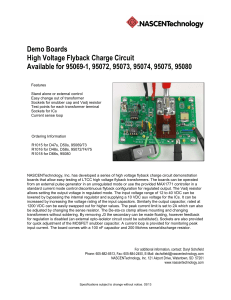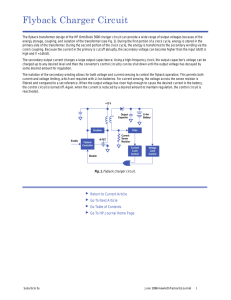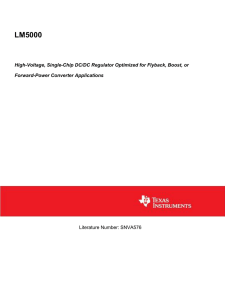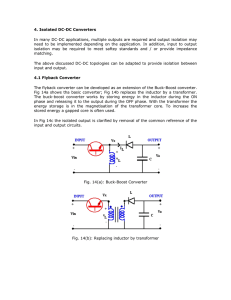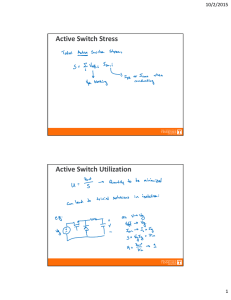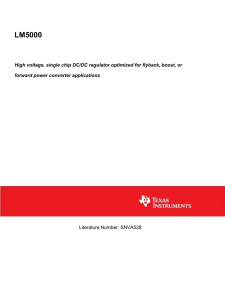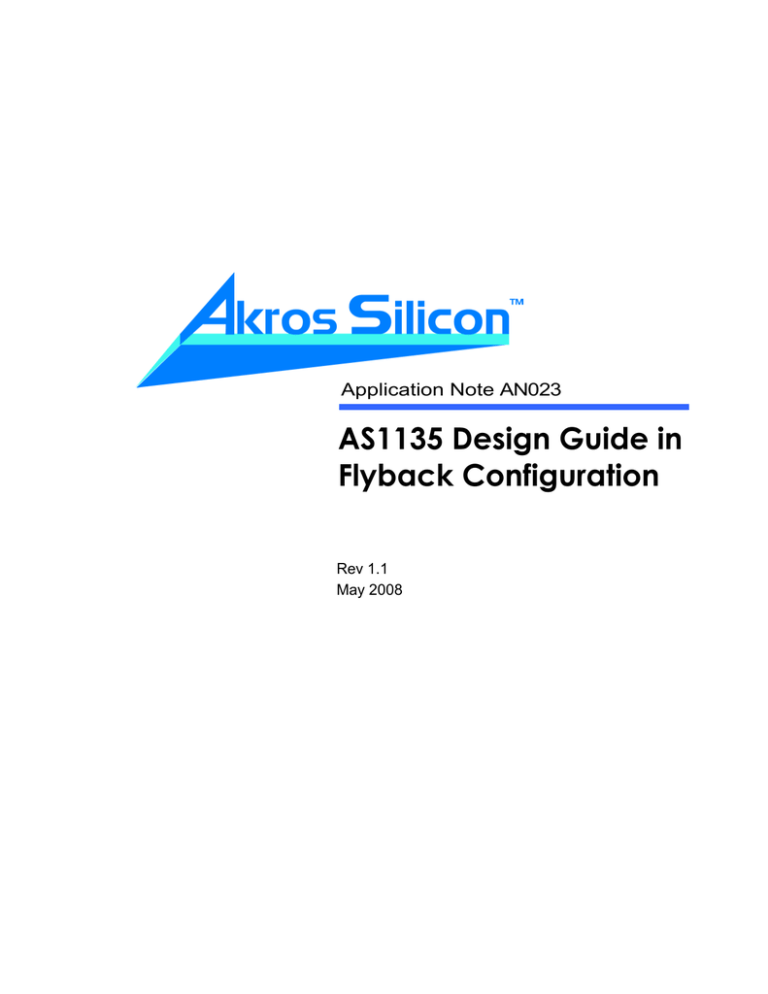
Application Note AN023
AS1135 Design Guide in
Flyback Configuration
Rev 1.1
May 2008
AS1135 Design Guide in Flyback Configuration
AN023
TABLE OF CONTENTS
TABLE OF CONTENTS .............................................................................................................................................2
FIGURES ....................................................................................................................................................................3
TABLES .....................................................................................................................................................................3
ABOUT APPLICATION NOTE AN023 ......................................................................................................................3
INTRODUCTION ........................................................................................................................................................4
CIRCUIT DESIGN ......................................................................................................................................................4
PI Interface ............................................................................................................................................................4
PD Setup ...............................................................................................................................................................4
Current Limit and Classification .......................................................................................................................4
Maintain Power Signature (MPS).....................................................................................................................4
Isolated Flyback DC-DC Converter Design Techniques .......................................................................................4
Input Noise Filter at VDD48O...........................................................................................................................5
Snubbing Circuit Design...................................................................................................................................5
Synchronization FET Selection ........................................................................................................................6
Control-loop Stability vs. Crossover Frequency Tuning...................................................................................6
Opto-Coupler Biasing .......................................................................................................................................7
Soft Start and Short-Circuit Protection .............................................................................................................8
LV Mode Network vs. Input Voltage.................................................................................................................8
Power Transformer Selection...........................................................................................................................8
COMPONENT PLACEMENT .....................................................................................................................................9
Ethernet Signals ....................................................................................................................................................9
DC-DC Converter ..................................................................................................................................................9
Component Placement Example.........................................................................................................................10
ROUTING .................................................................................................................................................................12
Ethernet Signals ..................................................................................................................................................12
DC-DC Converter ................................................................................................................................................12
Thermal Pad ........................................................................................................................................................12
Stack-up and General Layout Guidelines ...........................................................................................................12
Ground Layers.....................................................................................................................................................12
Layout Example...................................................................................................................................................13
APPENDIX A - EXAMPLE SCHEMATICS ..............................................................................................................18
REFERENCE MATERIALS .....................................................................................................................................20
CONTACT INFORMATION......................................................................................................................................21
Legal Notice.........................................................................................................................................................21
Reference Design Policy .....................................................................................................................................21
Life Support Policy...............................................................................................................................................21
Substance Compliance .......................................................................................................................................21
2
AN023
AS1135 Design Guide in Flyback Configuration
FIGURES
Figure 1 - Pi-Type Filter ..............................................................................................................................................5
Figure 2 - Snubbing Circuits Used in AS1135 Flyback EVB ......................................................................................5
Figure 3 - Control Loop Section at the Output............................................................................................................6
Figure 4 - Control-loop Section Close to the DC-DC Controller .................................................................................6
Figure 5 - Short-Circuit Protection ..............................................................................................................................8
Figure 6 - Top-Side Component Placement.............................................................................................................10
Figure 7 - Bottom-Side Component Placement........................................................................................................11
Figure 8 - Layout Example – Top Assembly ............................................................................................................13
Figure 9 - Layout Example – Top Layer ...................................................................................................................14
Figure 10 - Recommended Ground Plane Split using Magjack – Shown in Ground Layers 1, 2 and 3 ..................15
Figure 11 - Layout Example – Bottom Layer ............................................................................................................16
Figure 12 - Layout Example – Bottom Assembly .....................................................................................................17
Figure 13 - Schematic of AS1135-EV-SYNC-FL5V30W (Line Interface and PD) ...................................................18
Figure 14 - Schematic of AS1135-EV-SYNC-FL5V30W (DC-DC Converter) ..........................................................19
TABLES
Table 1 - Classification Resistors ...............................................................................................................................4
ABOUT APPLICATION NOTE AN023
Application Note AN023 describes the methodology for designing an Akros Silicon PD/PWM component into PoE applications using a
single-output flyback configuration. This document applies to all flyback designs using the AS1135, even though some diagrams may
demonstrate concepts using voltages or power levels specific to only one particular design configuration.
The family of Akros AS1135 Flyback Evaluation Boards (EVB) consists of different configurations, including but not limited to the following:
Regular PoE / local-power inputs of 36-57V
Low local-power 12V input, plus standard 36-57V PoE input range
3.3V output
5V output
12V output
Isolated synchronous
Isolated non-synchronous
13W input
30W input
Please Refer to Application Note AN021 – AS1135-EV-Flyback Boards - User Guide for usage information on these boards.
3
AS1135 Design Guide in Flyback Configuration
AN023
INTRODUCTION
PD SETUP
This guide is intended to provide general guidelines for
designing with the Akros AS1135 Powered Device (PD)
Controller & DC-DC Controller in flyback configuration. It is
intended to be used in conjunction with the following documents:
Current Limit and Classification
Akros Silicon Datasheet:
AS1135 Datasheet
Akros Silicon Application Note:
AN006 – Using PoE PD with a Local Power Supply
Akros Silicon Application Note:
AN021 - AS1135 EV Flyback Board User Guide
Evaluation Boards (containing reference designs):
AS1135-EV-FL3.3-30W
AS1135-EV-FL5-30W
AS1135-EV-FL3.3-30W
It also provides procedures for adapting the reference designs
for specific device applications.
For questions or additional information, please contact Akros
Application Support engineers through your sales
representative, or via email at: support@akrossilicon.com.
RCURR and RCLASS are used for programming PDcompliance levels in the Akros AS1135 component.
RCURR sets the on-board current limit. When the pin is left
unconnected, current is limited to ≤ 900mA. When connected to
ground, the current limit is restricted to ≤ 500mA. Refer to the
AS1135 datasheet for specific design limitations.
RCLASS sets the user-programmable classification current
level. Each class represents a power-allocation range for a PD,
allowing the PSE system to intelligently manage power
distribution to each PD that it supports.
Recommended resistance values for the RCLASS pin are listed
in Table 1. Refer to the AS1135 Datasheet for more information
on resistor selection. For higher-power, pre-IEEE 802.3at
applications, use of Class 4 is required.
Table 1 - Classification Resistors
Class
Power
(Watts)
ICLASS
RCLASS
0
0.44-12.95
0-4 mA
pull-up
1
0.44-3.84
9-12 mA
280k Ω
2
3.84-6.49
17-20 mA
143k Ω
PI INTERFACE
3
6.49-12.95
26-30 mA
90.9k Ω
IEEE 802.3af/at-compliant systems will use either Alternative A
or Alternative B power connectivity. Akros recommends that
designers adhere to standard IEEE connectivity methodology.
4
Reserved
36-44 mA
63.4k Ω
CIRCUIT DESIGN
Two external diode bridges are employed to enable connection
to the Ethernet RJ45 signals, such that the PD can support any
combination of Power Supply Equipment (PSE) polarity and
operation mode. Note: IEEE 802.3af/at does not support that a
PD be capable of operation in only one of the two modes,
Alternative A or B. For compliance, designers must support all
allowable combinations.
Any qualified PoE Plus (PoE+) transformer or Magjack may be
used as the PI interface for 10/100/1000 or 10/100 base
Ethernet system connectivity. Ferrite beads L3-L6 in Figure 13
are recommended for additional EMI filtering between the PD
and the transformer center taps for robust EMI performance.
Place these components close to the Ethernet transformer /
Magjack. If discrete components are to be used, please consult
with the Ethernet transformer vendor to ensure that it is PoE+
compatible and that input current will be well balanced between
the data lines.
Maintain Power Signature (MPS)
For the PD to continually receive power from the PSE, it must
maintain its power signature so the PSE continues to see a valid
load profile. For more info on MPS, please refer to Appendix A
of Application Note AN006 – Using PoE Powered Devices with a
Local Power Supply.
ISOLATED FLYBACK DC-DC CONVERTER
DESIGN TECHNIQUES
The AS1135 supports isolated forward flyback and non-isolated
buck DC-DC topologies. Information on the different topologies
can be found in the AS1135 datasheet.
Designers must also decide whether or not their architecture
requires power isolation. If the system will be non-isolated, then
the high-voltage and low-voltage grounds should be connected
together.
If the system will be isolated, then an opto-coupler is required on
the feedback line to ensure that no DC path connects the two
4
AN023
AS1135 Design Guide in Flyback Configuration
sides of the circuit. To reduce common-mode noise on the
Ethernet lines, a 4700pF, 2KV cap is recommended between
PoE ground and board ground.
Input Noise Filter at VDD48O
A pi-type filter should be employed on the VDD48O pin, to
reduce the amount of noise on the line. The following filter is
recommended between the PD VDD48O pin and the
transformer primary-winding node:
Figure 1 - Pi-Type Filter
There are three snubbing circuits used in the AS1135 reference
design shown in Figure 2. One snubbing circuit consists of R59,
C35, R62, D6 and D20. Normally, resistor R62 is not installed. If
R62 is to be employed, then do not place a resistor in R59.
Another snubbing circuit is comprised of R78, C43, D12 and D8.
The third snubbing circuit example contains C46, R90 and D16.
In designing an AS1135 snubbing circuit, designers should
begin by measuring the frequency of the ring without the
snubbing circuit in place, then begin circuit tuning by adding a
small capacitor (in the 100pF range) across the device and
again observing the ring. Then, increase the capacitance until
the ring is roughly halved and note the capacitor value. The
actual capacitor to be used in the design will be 75% of the
capacitance value just determined.
Add a 25ohm resistor in series with this capacitor and then keep
increasing the resistance until the ring is nearly eliminated.
Capacitors should be the ceramic type, which have low ESR
and ESL properties. Avoid wire-wound resistors, which have
excessively-high ESL.
In addition, designers must ensure that any device connected to
VDD48O be rated to safely handle at least 80V and >1A.
Snubbing Circuit Design
The most common snubbing circuit is the R/C, which is placed
as close as practical across the device being protected. The R/C
time constant of the circuit should be small in comparison to the
switching period, but long relative to the voltage rise time. The
capacitor must be larger than the parasitic capacitance, but as
small as possible, to minimize power dissipation through the
snubbing resistor.
Figure 2 - Snubbing Circuits Used in AS1135
Flyback EVB
Another design consideration is the sync winding, which is used
to drive the Synchronization FET. Usually a back-to-back Zener
is used to clamp the winding voltage to a safe level for the VGS =
20V rating of most FETs. 0.5W, 16V Zeners are ideal for most
applications .
The benefit of a Zener circuit over an R/C snubber or a gatedrive resistor is that the switching time is not affected,
minimizing overlap losses. In some cases, however, a gatedrive resistor or snubber may be required. Designers should
experiment to determine the optimal solution for their
application.
Adding a snubbing circuit to minimize spikes and ringing can be
beneficial for device protection and EMI, but the undesirable
effect is a slower switching time, which impacts efficiency. Care
must be taken in selecting these components and observing the
effects. Board layout plays a significant role in circuit
performance, along with transformer parasitics.
Besides the snubbing circuit, in the AS1135 reference designs,
various EMI suppression techniques are implemented as
backup solutions whenever needed. For example:
Resistor R57 can be used to slow down the rising edge
of the primary switching FET.
Resistor R77 (not shown in Figure 2) can be added into
the design between pin 11 of transformer T3 and the
gate of Q4 to reduce spike stretches on the Sync FET for
better EMI performance (for 5-10ohm).
Since lab test results show that Akros EVB EMI emissions are
already well controlled, resistors R57 and R77 are populated
with zero-ohm resistors.
5
AS1135 Design Guide in Flyback Configuration
Synchronization FET Selection
AN023
Figure 3 - Control Loop Section at the Output
In general, adding a synchronization (sync) circuit, improves the
DC-DC converter efficiency by a few percent. However, care
must be taken when selecting the sync FET component. The
major parameters important to circuit efficiency are the drain to
source resistance, the rise/fall times and the total gate charge.
RDSON value should be in the 8-16 mΩ range. FET rise/fall
times should be approximately 10ns. The important parameters
to prevent FET component stress are the maximum drain to
source voltage and the maximum gate to source voltage. Under
no-load or light-load conditions, the peak voltage across the
drain-to-source might exceed the VDS rating of the FET. System
designers should tune the transformer duty cycle to minimize
this stress.
One FET qualified by Akros is the International Rectifier
IRF7807Z. However, IRF8714 or the ON Semiconductor
NTMS4872NR2G may work as well. It is the designer’s
responsibility to assure that FET and circuit parameters are not
exceeded.
Akros recommended reference designs, including the
recommended transformers and sync FET, have been optimized
to keep node voltages around the sync FET within their
desirable ranges, to avoid overstressing components.
Control-loop Stability vs. Crossover
Frequency Tuning
A conventional optically-isolated error op-amp is used to
compensate for control-loop stability. The system control loop
shown in Figure 3 and Figure 4 has two poles, P1 and P2, and
one zero, Z1, to compensate the loop.
Pole P1 is formed by AEA - the DC gain and capacitor C21.
Pole P2 is created by the equivalent output capacitor and load
resistor. The zero is formed from feedback compensation
resistor R56 and capacitor C21.
An additional zero Z2 and pole P3 may be optionally employed
for added phase margin and to cancel high-frequency noise, if
required. The extra pole and zero are formed from capacitors
C22 and C27 and resistor R26.
6
Figure 4 - Control-loop Section Close to the DCDC Controller
AN023
AS1135 Design Guide in Flyback Configuration
Poles and zeros are calculated with these equations:
RLOAD
VOUT
I MAX
N PRIMARY
N SECONDARY
D
N VOUT
VIN N VOUT
1
2 COUT RLOAD
1
2 C 21 R56
The additional pole and zero are calculated using:
f P3
1
2 C 27 R 26
fZ 2
1
2 C 22 R 26
Selecting appropriate component values for pole and zero
positions is the key to achieving the desired high DC gain,
phase margin, gain margin and gain crossover frequency that is
the hallmark of a stable system.
The general rule of thumb is to set pole P1 at the gain crossover
frequency, which will determine the value for capacitor C21. The
gain crossover frequency must be less than one-sixth of the
switching frequency (FSW). Then, set zero Z1 at pole P2.
The optional zero Z2 and pole P3 can be implemented if the
system still requires additional phase and higher DC gain for
better load regulation. When the zero associated with the output
capacitor ESR (Equivalent Series Resistance) is less than one
half of FSW, this additional pole and zero can be used to
compensate for or minimize the effect caused by the ESR.
Note: Once the additional pole and zero are employed in the
design, zero Z2 must be set at pole P2. Zero Z1 will be set
farther out at 10*P2. Set P3 equal to the zero of the ESR (ZESR),
using the calculation:
f ZESR
where:
RLOAD is the load resistor
1
f P1 AEA
2 C 21
f Z1
RL OAD 1 D N 2
2 LP D
2
Z RHP
N
f P2
One further issue designers should pay attention to in flyback
designs is the Right Half Plan Zero (RHPZ), which can be found
using the following formula:
D is the duty cycle.
N is the turns ratio of primary to secondary
LP is the primary inductance of the transformer.
To minimize the effect of Right Half Plan Zero, the gain
crossover frequency FC should be also set to less than one-third
of the RHPZ frequency.
Additional output filter inductor L7 may be employed, based on
the design’s low output ripple and clean no/full load transient
response requirements. Use of this inductor changes the
impedance of the load seen by the DC-DC control loop and will
require appropriate adjustments to the compensation-loop
components. Also, if applications require different output
capacitance than is specified in the Akros reference designs,
loop compensation is affected and appropriate component
tweaks will be required, using the preceding design guidelines.
Loop stability testing to generate Bode plots can be performed
with a traditional small-signal test setup. Transient load-step
response should also be checked, to ensure that the transient
behavior matches the measured AC-loop parameters. Details
for this testing, as well as selective test results on Akros
reference designs, are available in Akros Application Note
AN021.
Please consult with Akros’ Application Support engineers for
further assistance and proper component selection.
Opto-Coupler Biasing
U19 is an 8-pin, optically-isolated Error-Amplifier IC containing
an error amplifier and opto-coupler (see Figure 3 and Figure 4).
In order to function properly, the LED voltage at pin 8 should be
greater than 2.74V and the current-transfer ratio (IC/IF) should be
set within the minimum and maximum current-transfer ratio
(CTR) over the system’s operating temperature range.
The following equations can be used to calculate the optocoupler bias resistor values:
R 22
1
2 COUT RESR
R 23
VOUT
VBN
VLED
IF
VCOMP
IC
7
AS1135 Design Guide in Flyback Configuration
R64
VOUT
VREF
I SCOMP
IC/IF is the current transfer ratio
IF is the LED current set by R22
IC is the collector current set by R23
ISCOMP is the current flow into the error amplifier
compensation pin 6 of U19.
Akros-recommended voltage levels:
VLED = 2.74V, VCOMP = 1.8V, VREF = 1.24V.
In general, LED current IF is set between 2mA and 3mA, to
reduce power dissipation and extend the life of the opto-coupler.
R64 is used to supply 1-2mA into the error amplifier, to minimize
CTR variation over the entire temperature range.
Soft Start and Short-Circuit Protection
The Soft Start function is enabled by grounding the CSS pin
through a capacitor, as specified in the Electrical Characteristics
table in the AS1135 Datasheet (Soft Start Ramp Time).
Figure 5 - Short-Circuit Protection
AN023
Short-circuit protection for the device may be added to limit PD
input current or shut down the IC if a short occurs in the
application hardware. As shown in Figure 5, the optional shortcircuit protection schematic consists of the following
components: C18, D18, Q5, R28, R83, and R84.
The potential difference between bias winding pin 5 and 6 of
power transformer T3 is about 6.5V when the EVB is operating
steady state. Resistor R28 is selected small enough to ensure
that the voltage at the base of transistor Q5 is biased at more
than 3.5V. Capacitor C18 is used to hold up the charge, so that
the base voltage of the transistor is higher than its emitter
voltage, which is the voltage at the AS1135’s COMP pin minus
one diode voltage drop. Transistor Q5 stays biased ‘off’ during
normal steady state operation, keeping the short protection
circuit inactive.
However, if the output load becomes shorted, the output voltage
will lose regulation. The IC is forced to run at minimum duty
cycle in flyback topology. As a result, the base voltage of Q5 will
drop below 0.7V, due to the dropping bias-winding voltage when
the DC-DC converter output is shorted. Therefore, Q5 is turned
on and pulls the AS1135 COMP pin voltage down close to
ground. This limits the input current to less than 100mA until the
short is removed.
LV Mode Network vs. Input Voltage
There are still a number of applications that require local power
delivery for redundancy or when Ethernet connections at the site
are not PoE-capable.
By providing for the use of a wall power adapter, users have the
ability to deploy the same equipment in both PoE and non-PoE
environments. This also provides a ready migration path when
PoE is installed later on.
Diode D13 (see Figure 13 on page 18) is used to block a
reversing current from VDD48O. Its maximum leakage current
should be specified to be less than 350µA. Local power cabling
can cause EMI problems, so appropriate choke/filtering
components should be used to isolate the local power jack.
Refer to the AS1135 Datasheet and Application Note AN006 –
Using PoE Powered Devices with a Local Power Supply for
proper local-voltage mode network setup.
Power Transformer Selection
For the regular PoE input voltage, the transformer selection can
be relatively easy and the recommended vendors can provide
the support needed in the most cases. However, if the local
source voltage is significantly lower than the PoE line (<32V),
then special consideration must be taken in the transformer
circuit design.
Refer to AN006 – Using PoE Powered Devices with a Local
Power Supply for a list of qualified power transformers used in
different configurations.
8
AN023
AS1135 Design Guide in Flyback Configuration
Akros has a selection of recommended transformers from
leading magnetic suppliers that have been tested for proper
circuit performance. Akros highly recommends adhering to
Akros-proven transformer designs for optimal system cost and
performance, and to minimize the need for design reoptimization and validation.
COMPONENT PLACEMENT
Component selection and layout placement is very important for
good EMI, efficiency and output ripple performance. Appendix A
provides example evaluation board schematics for a power
splitter design with an isolated flyback DC-DC converter.
Example layouts from this board are also provided, to illustrate
desirable design and layout practices.
ETHERNET SIGNALS
No special placement consideration is required for the Ethernet
line components when designing with the AS1135; however, the
PD device should be placed as close to the center tap of the
transformer as possible, to limit the IR drop.
DC-DC CONVERTER
When using flyback topology, the NDRV FET and its associated
protection diodes should be placed as close as practical to the
PD/PWM Controller component. Ideally, place them on the
reverse side of the board, underneath the PD/PWM Controller.
The DC-DC transformer should be placed on the top side of the
board, to limit the distance between the switching FETs and the
transformer.
Ceramic bypass capacitor C10 should be placed as close as
possible to the PD/PWM Controller for optimum sourcing of the
switching current from the gate drive of the power FET. This will
assist in minimizing high-frequency ringing and ripple at the
VBN pin of the AS1135 component. The same applies for
decoupling capacitors C1 and C11.
Snubber circuits should be placed very close to the primary or
secondary FET where snubbing is required. They may be
placed on the back side of the FETs, as appropriate.
When placing components on both sides of the PCB, thermal
issues should be carefully considered. All active components in
the design (AS1135, FETs, diodes, etc.) require careful layout
and ground plane connectivity for thermal management. To
minimize the board’s thermal density and localized heating, no
two active components should be placed back-to-back on
opposite sides of the board.
The placement of the 2KV capacitors C13 and C14 is critical for
proper EMI performance. It is recommended that one be placed
on each side of transformer T3, to allow for design flexibility
during testing.
9
AS1135 Design Guide in Flyback Configuration
COMPONENT PLACEMENT EXAMPLE
Figure 6 and Figure 7 show example component placements for the top and bottom of a PC board:
Figure 6 - Top-Side Component Placement
10
AN023
AN023
AS1135 Design Guide in Flyback Configuration
Figure 7 - Bottom-Side Component Placement
11
AS1135 Design Guide in Flyback Configuration
ROUTING
ETHERNET SIGNALS
Ethernet signal routing on the secondary side of the input
transformer should follow the recommendations of the Ethernet
PHY supplier. The AS1135 does not require additional
consideration.
AN023
THERMAL PAD
The Akros-recommended 5x5mm 20-LD QFN footprint for the
AS1135 package should be followed. It is essential that the
bottom-side pad be used for both thermal and electrical contact.
A good solder connection is essential for optimal performance.
This pad should be filled with as many vias as is practical, to
ensure good thermal conductivity to the board’s ground plane.
In general, Ethernet data signals are high-frequency differential
signaling channels. Their routing should have 100ohm
differential impedance on both sides of the inputs to the
Ethernet transformer. Signal traces should avoid sharp bends
and sudden width changes, since this affects impedance and
current carrying capacity. Traces should also have appropriate
ground planes underneath, for common-mode signal return and
to shield against coupled noise from the DC-DC converter.
It is also recommended that a metal pad be placed on the
bottom side of the board. Avoid routing signals underneath. A
minimum of nine vias on the ground/thermal pad is required. For
additional information, refer to Application Note AN018 –
Thermal Characterization & QFN Layout Guide and AN022 –
AS1135 Thermal Characterization Report.
High-speed signals should be routed away from the DC-DC
converter, to prevent the converter switching noise from
appearing on the data lines.
For a multilayer board, ground and signal layers should be
internal layers, with 1oz copper pour on both the top and bottom
layers. Stitch the copper pour areas with ground layers of no
greater than 7mm pitch, to avoid islands. This will help with
thermal conduction, EMI emission and immunity. Separate
active signal layers, both to ensure good capacitance between
the layers and to ensure there is a solid reference or return for
the active signals.
Since the Ethernet transformer center-tap connections do not
carry data traffic, these traces should be drawn wider on the
circuit board to minimize the IR drop due to the relatively large
current (up to 1A) to and from the line. The increased width is
also recommended in order to carry this current without
excessive heating.
Ground planes should be solid and free of islands and choke
points, to ensure a low-impedance return path.
DC-DC CONVERTER
VDD48O signal routing should be at least 200mils wide and all
components directly connected to it should also be 200mils,
including the routing to the drain and gate of the FET between
the NDRV and the primary side of the transformer.
Traces leading from the secondary side of the DC-DC converter
should be appropriate for the output current of the converter. For
maximum power delivery, it is also recommended that a
minimum 200mil line width be used. Any layer transitions for
these high-power signals require multiple vias to ensure low
inductance and resistance. The length of all high-impedance
small signal traces should be kept to a minimum and shielded
from the switching power traces.
The AS1135’s PADDLE should be tied directly to the return of
C7 and C8, in a path that will not share the high-power current
associated with the DC-DC converter.
Minimizing the loop area for all high-frequency switching
currents helps reduce radiated EMI. Ceramic capacitors C7 and
C8 supply the high-frequency switching current for the primary
side of the integrated converter block in the PD Controller. The
loop area made by C7 and C8 with the return path tying to the
current-sense resistor R11 should be minimized.
12
STACK-UP AND GENERAL LAYOUT GUIDELINES
GROUND LAYERS
The DC-DC converter creates voltages isolated from the highvoltage signals coming in from the Ethernet line. For this reason,
two grounds are designed into the system, one for high voltage
and one for low voltage.
Grounds should be separated by a gap on the power and
ground planes, to reduce DC-DC noise coupling to the Ethernet
signals. Akros recommends a minimum gap of 50mils. Ground
planes should be 1oz copper and should be as continuous as
possible, with no isolated islands or narrow choke points.
To maintain ground separation, secondary-side components
and routing should be placed over the low-voltage ground plane.
Primary-side components and routing should be placed over the
high-voltage ground plane.
Maintain sufficient spacing between the traces leading to the
power transformer, as well as between the traces from the
transformer to other components on the board, to avoid
isolation-related issues.
For EMI consideration, Akros recommends not filling in the
ground plane under the power transformer, as shown in the
layout example. This reduces the coupling of switching events
from the magnetic transformer to the ground plane. The high
voltage/PoE ground should be treated as an island covered by
the low-voltage ground, as shown in Figure 10. Via stitching
should be used on the outer edges of the board, to ensure lowimpedance connectivity between the layers.
AN023
AS1135 Design Guide in Flyback Configuration
LAYOUT EXAMPLE
Figure 8 to Figure 12 are example layouts that apply to the
AS1135. Appendix A has corresponding schematics for the
implementation of a synchronized flyback-isolated converter.
design to meet various power, voltage and feature
requirements. An application-specific design may be somewhat
simplified based on the designer’s specific requirements.
Note that these designs include footprints and place holders for
a wide range of components, to allow Akros to modify the
Figure 8 - Layout Example – Top Assembly
13
AS1135 Design Guide in Flyback Configuration
Figure 9 - Layout Example – Top Layer
14
AN023
AN023
AS1135 Design Guide in Flyback Configuration
Figure 10 - Recommended Ground Plane Split using Magjack – Shown in
Ground Layers 1, 2 and 3
15
AS1135 Design Guide in Flyback Configuration
Figure 11 - Layout Example – Bottom Layer
16
AN023
AN023
AS1135 Design Guide in Flyback Configuration
Figure 12 - Layout Example – Bottom Assembly
17
AS1135 Design Guide in Flyback Configuration
APPENDIX A - EXAMPLE SCHEMATICS
Figure 13 - Schematic of AS1135-EV-SYNC-FL5V30W (Line Interface and PD)
18
AN023
AN023
AS1135 Design Guide in Flyback Configuration
Figure 14 - Schematic of AS1135-EV-SYNC-FL5V30W (DC-DC Converter)
19
AS1135 Design Guide in Flyback Configuration
REFERENCE MATERIALS
Akros Silicon Datasheet:
AS1135 Datasheet
Akros Silicon Application Note:
AN006 – Using PoE PD with a Local Power Supply
Akros Silicon Application Note:
AN021 - AS1135 EV Flyback Board User Guide
Evaluation Boards (containing reference designs):
AS1135-EV-FL3.3-30W
AS1135-EV-FL5-30W
AS1135-EV-FL3.3-30W
20
AN023
AN023
AS1135 Design Guide in Flyback Configuration
CONTACT INFORMATION
Akros Silicon Inc.
6399 San Ignacio Ave, Suite 250,
San Jose, CA 95119
USA
Tel: (408) 746-9000 ext. 100
Fax: (916) 351-8102
Website: www.akrossilicon.com
Email inquiries: marcom@akrossilicon.com
LEGAL NOTICE
Copyright © 2007 Akros SiliconTM. All rights reserved. Other names, brands and trademarks are the property of others. Akros SiliconTM
assumes no responsibility or liability for information contained in this document. Akros reserves the right to make corrections,
modifications, enhancements, improvements, and other changes to its products and services at any time and to discontinue any product or
services without notice. The information contained herein is believed to be accurate and reliable at the time of printing.
REFERENCE DESIGN POLICY
This document is provided as a design reference and Akros Silicon assumes no responsibility or liability for the information contained in
this document. Akros reserves the right to make corrections, modifications, enhancements, improvements and other changes to this
reference design documentation without notice.
Reference designs are created using Akros Silicon's published specifications as well as the published specifications of other device
manufacturers. This information may not be current at the time the reference design is built. Akros Silicon and/or its licensors do not
warrant the accuracy or completeness of the specifications or any information contained therein.
Akros does not warrant that the designs are production worthy. Customer should completely validate and test the design implementation to
confirm the system functionality for the end use application.
Akros Silicon provides its customers with limited product warranties, according to the standard Akros Silicon terms and conditions. For the
most current product information visit us at www.akrossilicon.com
LIFE SUPPORT POLICY
AKROS' PRODUCTS ARE NOT DESIGNED, INTENDED, OR AUTHORIZED FOR USE AS COMPONENTS IN LIFE SUPPORT
DEVICES OR SYSTEMS. NO WARRANTY, EXPRESS OR IMPLIED, IS MADE FOR THIS USE. AUTHORIZATION FOR SUCH USE
SHALL NOT BE GIVEN BY AKROS, AND THE PRODUCTS SHALL NOT BE USED IN SUCH DEVICES OR SYSTEMS, EXCEPT UPON
THE WRITTEN APPROVAL OF THE PRESIDENT OF AKROS FOLLOWING A DETERMINATION BY AKROS THAT SUCH USE IS
FEASIBLE. SUCH APPROVAL MAY BE WITHHELD FOR ANY OR NO REASON.
“Life support devices or systems” are devices or systems which (1) are intended for surgical implant into the human body, (2) support or
sustain human life, or (3) monitor critical bodily functions including, but not limited to, cardiac, respirator, and neurological functions, and
whose failure to perform can be reasonably expected to result in a significant bodily injury to the user. A “critical component” is any
component of a life support device or system whose failure to perform can be reasonably expected to cause the failure of the life support
device or system, or to affect its safety or effectiveness.
SUBSTANCE COMPLIANCE
With respect to any representation by Akros Silicon that its products are compliant with RoHS, Akros Silicon complies with the Restriction
of the use of Hazardous Substances Standard (“RoHS”), which is more formally known as Directive 2002/95/EC of the European
Parliament and of the Council of 27 January 2003 on the restriction of the use of certain hazardous substances in electrical and electronic
equipment. To the best of our knowledge the information is true and correct as of the date of the original publication of the information.
Akros Silicon bears no responsibility to update such statements.
21

